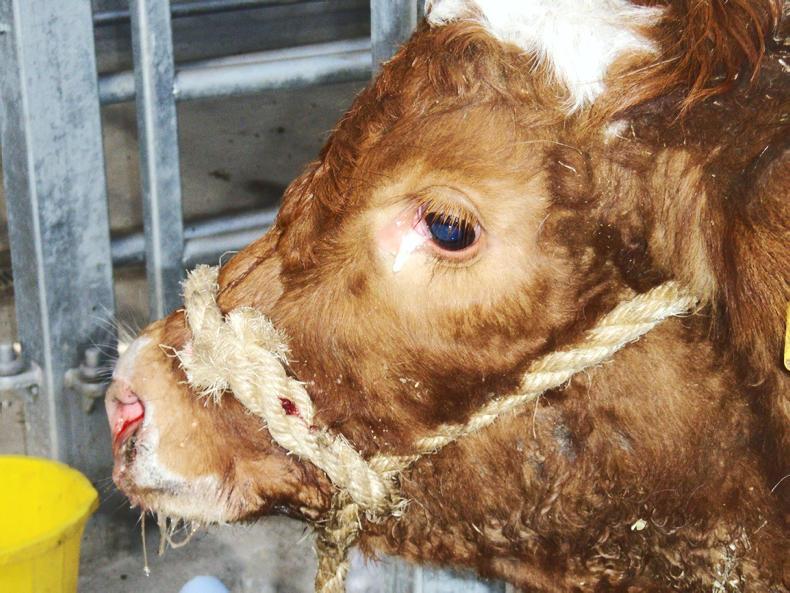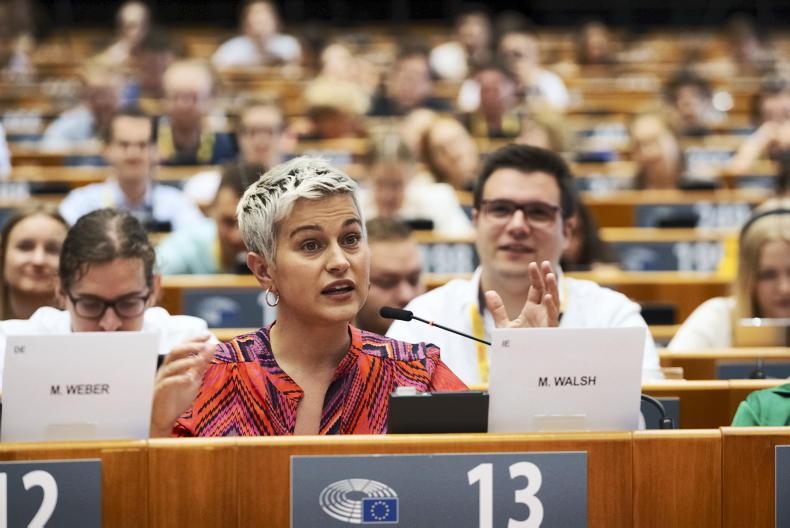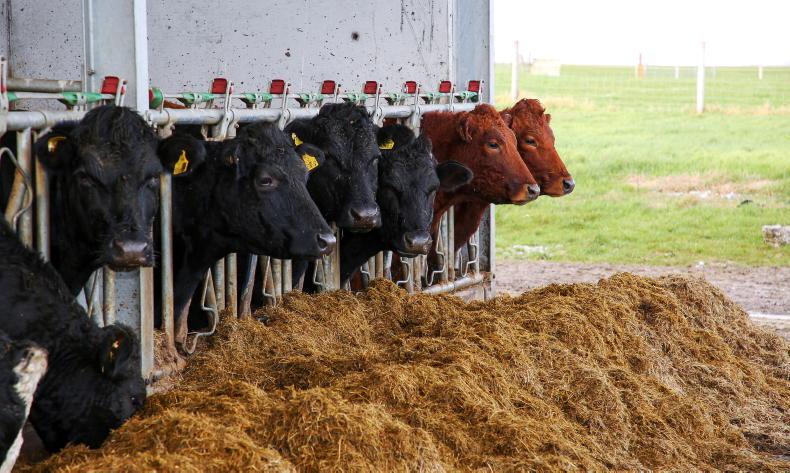Calf pneumonia is a costly and often deadly disease. Calves have small lungs when compared with their body size and healthy calf lungs are already working at maximum capability. Hence, any permanent lung damage caused by pneumonia makes it difficult for the calf to thrive, or even survive.
Most pneumonia cases are encountered in autumn/winter, often within one month of housing. With the highly variable weather conditions over the past few weeks, pneumonia cases have already become a common and frustrating problem for some cattle farmers.
The solution to calf pneumonia is not held within a bottle of antibiotics – involve your vet and look at the bigger picture. By understanding the factors which initiate pneumonia, identifying and treating pneumonia, and implementing preventative strategies, one can take active steps against calf pneumonia.
What is the cause?
Pneumonia is an inflammation of the tissue of the lungs, resulting from the response of the animal to either a virus and/or bacteria. The virus causes damage to lung tissue, so bacteria commonly found in the nose will then invade the compromised lung tissue and exacerbate lung disease. Additional environmental, management and nutritional factors play a large role in pneumonia outbreaks.
Common viruses that cause calf pneumonia:
RSV (Respiratory Syncitial Virus) – very severe pneumonia with rapid onset. Causes the majority of calf pneumonia cases.PI3 (Parainfluenza Type 3) – common flu-like symptoms, often mild, unless in combination with RSV.IBR (Infectious Bovine Rhinotracheitis) – often in older cattle, can occur as outbreak storms.BVD (Bovine Viral Diarrhoea) – affects the immune system, making infections with other pneumonia bugs more likely.Common bacterial causes of calf pneumonia:
Mannheimia haemolytica (Pasteurellosis) – often occurs two to three weeks after stress period, high stocking density and poor ventilation.Pasteurella multocida (Pasteurellosis) – see Mannheimia haemolytica.Haemophilus somni – can also cause brain and joint infections.Mycoplasma bovis – can also cause joint and middle ear infections. Poor response to antibiotic treatment resulting in chronic pneumonia. Contributing factors to calf
pneumonia:
Poor colostrum intake/ time of weaning – influence on immune status of the calf.Environmental factors – damp and warm weather, draughts, poor ventilation and stale air.Stress – transport, grouping, dehorning, castration, weaning, stocking density.Nutrition – inadequate nutrition will prevent an adequate immune system to develop.What are symptoms of calf
pneumonia?
Occasionally, calves will look well, but will have a raised body temperature (>39.5°C/ >103°F). The first sign of disease is usually loss of appetite and, therefore, the temperature should be taken of any animal not eating normally.
Coughing, runny nose, runny eyes and increased breathing effort can all be signs of pneumonia. However, coughing and nasal discharge can also be signs of poor ventilation and stale air.
A calf that is coughing without a fever or change in respiratory rate may just need fresh air. Calves that stand with their backs arched and heads down, breathing heavily, are sweating and depressed – most likely suffer from severe pneumonia cases or chronic cases.
It is important to realise that where there are one or two calves showing obvious signs of pneumonia, often five times more animals in the same group are likely to suffer from (the early stages of) pneumonia.
How to diagnose pneumonia causes in calves?
Although clinical signs might give away that a calf is suffering from pneumonia, it will not tell you which bugs are causing the pneumonia. The best way to find out which infectious organisms are causing an issue – and thus finding out which treatment or prevention should be implemented – is to have your vet take some samples.
This will usually involve taking some blood samples from older youngstock that have been similarly managed as the currently affected calves.
The blood samples may tell us which pneumonia bugs they encountered as younger calves.
Nasal swabs can occasionally be taken as well, but remember that most of the pneumonia bacteria normally live in the nose without causing disease. Tracheal washes will show which bacteria have descended to the lungs and are more appropriate than nasal swabs. Lung samples taken from post-mortem examinations are important, but are only of any use when taken quickly and cleanly from acute death cases.
How to treat pneumonia?
Regardless of the cause, all calves with pneumonia should be treated with an antibiotic as soon as possible. Once a large amount of lung damage has occurred, all antibiotics will fail.
The choice of approved antibiotic treatment is very bug and farm dependent, and should be recommended by your veterinarian following sample results and farm history data.
Additional anti-inflammatory treatments are important as they reduce lung inflammation, fever and restore growth rates and appetite. In some situations, whole group treatment may be considered, but always follow label recommendations of the treatment used and use antibiotics responsibly.
Preventing cal pneumonia
As with all diseases, prevention is better than cure and there are many management aspects to be considered to reduce the risk of a pneumonia outbreak.
Calves should be born into a clean, dry environment and be given adequate amounts of good-quality colostrum. If pneumonia cases are seen in calves under one month of age, colostrum management should be assessed.
Calves need fresh, draft-free air at all times. Too much moisture, lack of fresh air and excessive air speed are all detrimental to either the number of bugs in the air or the immunity of the calves.
A “smoke bomb” test can be carried out to assess how effective the ventilation is. Avoiding stress by separating multiple stressors (such as weaning, moving/mixing, dehorning and castrating) by at least a week and undertake them before housing, or delay them until calves have been housed for at least six weeks – this is paramount.
Vaccination
Vaccines are an important way of helping to control pneumonia on-farm but vaccines are not perfect, and should not be seen as a substitute for good calf management, housing and ventilation.
A multitude of pneumonia vaccines are on the market with protective effects against either single or multiple pneumonia causes. Ask for advice from your vet about which vaccines and vaccination protocols are best suited for your situation. Always make sure that your vaccination programmes are timed, so they are completed about a month ahead of the main risk period (ie housing).
Calf pneumonia is a costly and often deadly disease. Calves have small lungs when compared with their body size and healthy calf lungs are already working at maximum capability. Hence, any permanent lung damage caused by pneumonia makes it difficult for the calf to thrive, or even survive.
Most pneumonia cases are encountered in autumn/winter, often within one month of housing. With the highly variable weather conditions over the past few weeks, pneumonia cases have already become a common and frustrating problem for some cattle farmers.
The solution to calf pneumonia is not held within a bottle of antibiotics – involve your vet and look at the bigger picture. By understanding the factors which initiate pneumonia, identifying and treating pneumonia, and implementing preventative strategies, one can take active steps against calf pneumonia.
What is the cause?
Pneumonia is an inflammation of the tissue of the lungs, resulting from the response of the animal to either a virus and/or bacteria. The virus causes damage to lung tissue, so bacteria commonly found in the nose will then invade the compromised lung tissue and exacerbate lung disease. Additional environmental, management and nutritional factors play a large role in pneumonia outbreaks.
Common viruses that cause calf pneumonia:
RSV (Respiratory Syncitial Virus) – very severe pneumonia with rapid onset. Causes the majority of calf pneumonia cases.PI3 (Parainfluenza Type 3) – common flu-like symptoms, often mild, unless in combination with RSV.IBR (Infectious Bovine Rhinotracheitis) – often in older cattle, can occur as outbreak storms.BVD (Bovine Viral Diarrhoea) – affects the immune system, making infections with other pneumonia bugs more likely.Common bacterial causes of calf pneumonia:
Mannheimia haemolytica (Pasteurellosis) – often occurs two to three weeks after stress period, high stocking density and poor ventilation.Pasteurella multocida (Pasteurellosis) – see Mannheimia haemolytica.Haemophilus somni – can also cause brain and joint infections.Mycoplasma bovis – can also cause joint and middle ear infections. Poor response to antibiotic treatment resulting in chronic pneumonia. Contributing factors to calf
pneumonia:
Poor colostrum intake/ time of weaning – influence on immune status of the calf.Environmental factors – damp and warm weather, draughts, poor ventilation and stale air.Stress – transport, grouping, dehorning, castration, weaning, stocking density.Nutrition – inadequate nutrition will prevent an adequate immune system to develop.What are symptoms of calf
pneumonia?
Occasionally, calves will look well, but will have a raised body temperature (>39.5°C/ >103°F). The first sign of disease is usually loss of appetite and, therefore, the temperature should be taken of any animal not eating normally.
Coughing, runny nose, runny eyes and increased breathing effort can all be signs of pneumonia. However, coughing and nasal discharge can also be signs of poor ventilation and stale air.
A calf that is coughing without a fever or change in respiratory rate may just need fresh air. Calves that stand with their backs arched and heads down, breathing heavily, are sweating and depressed – most likely suffer from severe pneumonia cases or chronic cases.
It is important to realise that where there are one or two calves showing obvious signs of pneumonia, often five times more animals in the same group are likely to suffer from (the early stages of) pneumonia.
How to diagnose pneumonia causes in calves?
Although clinical signs might give away that a calf is suffering from pneumonia, it will not tell you which bugs are causing the pneumonia. The best way to find out which infectious organisms are causing an issue – and thus finding out which treatment or prevention should be implemented – is to have your vet take some samples.
This will usually involve taking some blood samples from older youngstock that have been similarly managed as the currently affected calves.
The blood samples may tell us which pneumonia bugs they encountered as younger calves.
Nasal swabs can occasionally be taken as well, but remember that most of the pneumonia bacteria normally live in the nose without causing disease. Tracheal washes will show which bacteria have descended to the lungs and are more appropriate than nasal swabs. Lung samples taken from post-mortem examinations are important, but are only of any use when taken quickly and cleanly from acute death cases.
How to treat pneumonia?
Regardless of the cause, all calves with pneumonia should be treated with an antibiotic as soon as possible. Once a large amount of lung damage has occurred, all antibiotics will fail.
The choice of approved antibiotic treatment is very bug and farm dependent, and should be recommended by your veterinarian following sample results and farm history data.
Additional anti-inflammatory treatments are important as they reduce lung inflammation, fever and restore growth rates and appetite. In some situations, whole group treatment may be considered, but always follow label recommendations of the treatment used and use antibiotics responsibly.
Preventing cal pneumonia
As with all diseases, prevention is better than cure and there are many management aspects to be considered to reduce the risk of a pneumonia outbreak.
Calves should be born into a clean, dry environment and be given adequate amounts of good-quality colostrum. If pneumonia cases are seen in calves under one month of age, colostrum management should be assessed.
Calves need fresh, draft-free air at all times. Too much moisture, lack of fresh air and excessive air speed are all detrimental to either the number of bugs in the air or the immunity of the calves.
A “smoke bomb” test can be carried out to assess how effective the ventilation is. Avoiding stress by separating multiple stressors (such as weaning, moving/mixing, dehorning and castrating) by at least a week and undertake them before housing, or delay them until calves have been housed for at least six weeks – this is paramount.
Vaccination
Vaccines are an important way of helping to control pneumonia on-farm but vaccines are not perfect, and should not be seen as a substitute for good calf management, housing and ventilation.
A multitude of pneumonia vaccines are on the market with protective effects against either single or multiple pneumonia causes. Ask for advice from your vet about which vaccines and vaccination protocols are best suited for your situation. Always make sure that your vaccination programmes are timed, so they are completed about a month ahead of the main risk period (ie housing).














SHARING OPTIONS